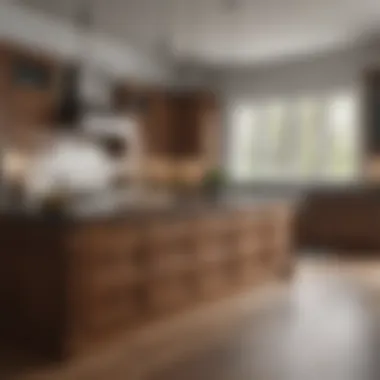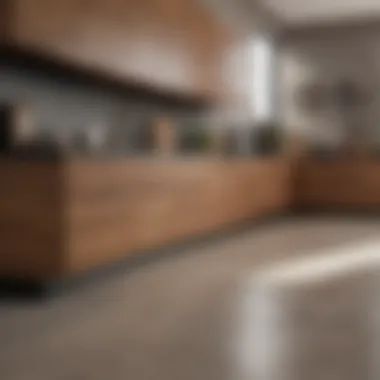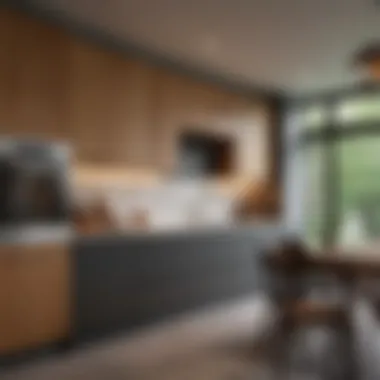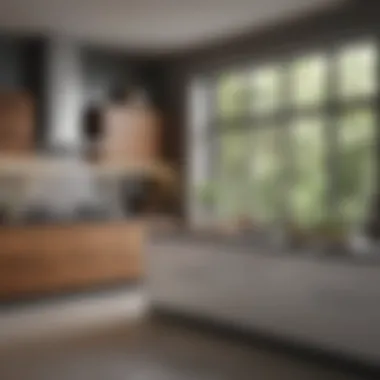Transform Your Space with Custom Kitchen Cabinets


Intro
Quality custom kitchen cabinets play a pivotal role in any home, influencing both aesthetics and functionality. These cabinets are not merely storage solutions; they are vital components of a well-designed kitchen. Investing in custom cabinetry allows homeowners to reflect their style while maximizing the efficiency of their space.
In recent years, the trend towards customization has surged, with homeowners seeking to create unique environments. From sleek modern designs to more traditional styles, custom cabinets offer something for everyone. Understanding the importance of selecting the right materials, colors, and designs is crucial. The choice of cabinetry can greatly affect not only the visual appeal of a kitchen but also its usability and longevity.
This article explores various aspects related to quality custom kitchen cabinets. Key insights into industry trends, practical tips on design and installation, and a comprehensive guide to materials will be presented. Whether you’re planning a remodel or designing your kitchen from scratch, this guide will enhance your knowledge and ensure informed decisions.
Prolusion to Custom Kitchen Cabinets
The kitchen is often considered the heart of a home. Therefore, the cabinets play a crucial role in defining the space's functionality and overall aesthetic. Custom kitchen cabinets offer unique solutions tailored to both style and practical needs. Understanding this topic is important because the right cabinetry can enhance not only the kitchen's look, but also its utility. Custom cabinets provide opportunities for personalization, maximizing storage space, and improving organization.
Defining Custom Kitchen Cabinets
Custom kitchen cabinets refer to cabinetry that is made to specific measurements and preferences. Unlike stock cabinets, which are pre-manufactured and come in standard sizes, custom cabinets are designed to fit the unique dimensions of a kitchen. This allows homeowners to utilize every square inch, leading to improved storage efficiency and organization. The materials, finishes, and designs can be selected to speak to the individual’s taste, creating a truly bespoke environment.
The Rise in Popularity of Custom Solutions
In recent years, the demand for custom kitchen cabinets has increased significantly. Many homeowners recognize the value of investing in tailored cabinetry. This rise in popularity can be attributed to several factors:
- Increased focus on home improvement: More people are choosing to renovate rather than move, leading to a higher interest in custom solutions.
- Shift towards personalization: Homeowners want spaces that reflect their personal style and meet their specific needs.
- Technological advancements: Improvements in manufacturing and design technologies have made customization more accessible.
As a result, custom kitchen cabinets are not just a trend; they reflect a broader shift towards personalized living spaces that function efficiently while looking aesthetically pleasing.
"Custom kitchen cabinets transform mundane spaces into beautiful and functional environments, enhancing both daily living and overall home value."
Advantages of Quality Custom Cabinets
Quality custom kitchen cabinets offer numerous advantages that can enhance not only the kitchen’s aesthetics but also its overall functionality. The investment in custom cabinetry pays off in various ways, addressing the needs of homeowners seeking a perfect balance between style and practicality.
Tailored Designs for Unique Spaces
One of the primary benefits of custom cabinets is their ability to be tailored to fit unique spaces. Unlike pre-made units, custom cabinets can be designed to maximize every inch of available space. This is particularly important for kitchens that have irregular layouts or architectural features.
Custom designs also allow homeowners to reflect their personal style. You can choose everything from the cabinet size to the drawer configurations and door styles. Such flexibility means you do not have to settle for less attractive or functional solutions. For example, a compact kitchen can benefit from pull-out shelves or corner cabinets that effectively utilize otherwise wasted areas.
Durability and Long-Term Value
Another compelling aspect of custom cabinets is their durability. Quality materials and craftsmanship lead to cabinets that can withstand the rigors of daily use. Unlike mass-produced alternatives, which might sacrifice quality for cost savings, custom cabinets can be built from superior materials. Solid wood, for instance, offers both strength and aesthetic appeal, ensuring that your investment lasts for years.
In terms of long-term value, quality custom cabinets can significantly enhance the marketability of a home. Potential buyers often perceive custom cabinetry as a luxury feature, which can contribute to a favorable appraisal during property evaluations. This makes them not only a practical choice for homeowners but also a strategic investment.
Enhanced Functionality with Custom Features
Custom cabinets excel in expanding functionality through innovative features. Many homeowners prioritize comfort and efficiency in their kitchen layouts. Custom designs can accommodate modern conveniences like pull-out trash bins, integrated spice racks, and temperature-controlled wine storage.
Additionally, custom cabinetry can incorporate organizational solutions tailored to individual cooking and hosting styles. Thoughtful design in cabinetry means that everything from utensils to larger pots can be easily accessible, making the cooking experience more enjoyable. Homeowners can opt for adjustable shelving or specialized compartments to suit their needs, making meal prep and clean-up more efficient.
"Custom cabinets can transform a kitchen into a highly personalized and functional space that reflects your lifestyle and preferences."
Key Considerations Before Designing Custom Cabinets
When embarking on the journey of designing custom kitchen cabinets, several key considerations must come into play. These elements are crucial, as they play a significant role in ensuring that the final product not only meets your aesthetic preferences but also functions well in your kitchen space. Understanding these factors can help in making the right decisions that enhance your kitchen's usability and visual appeal.
Assessing Your Kitchen Space
Assessing your kitchen space is perhaps the most vital first step. It involves taking precise measurements and understanding the overall layout. Consider the flow of movement in the kitchen. Are there any obstructions such as doors, windows, or appliances that will affect cabinet placements?
You need to think about how to use the space effectively. Creating zones for different activities—cooking, cleaning, and socializing—can improve the kitchen's functionality. Plan for cabinet heights and depths that work harmoniously with your existing appliances. The space should feel balanced, and thus it is essential to have both the measurements and layout decided clearly.
Budgeting for Custom Cabinets
Budgeting is a key consideration that can determine the scope of your custom cabinet project. Quality custom cabinets can range significantly in price depending on materials, design complexities, and craftsmanship. Therefore, establishing a realistic budget should come first.


Begin by researching average costs of materials like plywood, solid wood, or laminate. Custom features, such as soft-close drawers and specialized storage solutions, may add to the cost. Also, keep in mind the expenses associated with labor if hiring a professional.
It's essential to prioritize your needs versus wants. Focus on what is most necessary for your kitchen renovation. Allocating a budget can not only help in narrowing down choices but also in managing expectations throughout the project.
Choosing the Right Designer or Craftsman
The selection of the right designer or craftsman can significantly influence the outcome of your custom cabinets. Ideally, you want someone who understands your vision and has experience in creating quality cabinetry. Start by researching potential candidates—look for reviews, past projects, and a portfolio that resonates with your style.
Communication is key here. Ensure that the designer or craftsman listens to your ideas and offers constructive feedback. Ask about their previous work to gauge their understanding of different kitchen styles and functionalities.
Don’t hesitate to seek quotes from multiple professionals before making a decision. It’s not merely about cost, but the overall compatibility with your vision and expectations for the project.
Remember, custom cabinets are a long-term investment. Choosing the right team can make all the difference in bringing your dream kitchen to life, enhancing both its beauty and functionality.
Materials Used in Custom Kitchen Cabinets
Understanding the materials used in custom kitchen cabinets is crucial for homeowners seeking to make informed decisions about their kitchen renovations. The selection of materials influences not only the aesthetics of the space but also the durability, functionality, and overall quality of the cabinets. A well-chosen material can make a significant difference in the kitchen environment, creating a harmonious blend of style and practicality.
Wood Types and Their Properties
Wood is the traditional choice for custom kitchen cabinets, valued for its strength and beauty. Each type of wood has unique properties. For instance, maple is a popular choice due to its hardness and resistance to abrasion. It can hold heavy weights, making it ideal for cabinetry.
- Oak is another common wood, known for its visible grain patterns. It offers durability and can resist warping.
- Cherry wood is favored for its rich color, which darkens with age, adding character to cabinets over time.
- Birch is a cost-effective alternative that still provides a smooth finish, suitable for painting or staining.
When selecting wood, it is important to consider factors like the kitchen’s humidity levels and the wood’s susceptibility to scratches or dents.
Alternative Materials: Pros and Cons
In addition to wood, alternative materials such as plywood, MDF, and particleboard are used in custom cabinetry. Each material has its pros and cons.
- Plywood is made from layers of wood veneer; it is strong and resistant to warping. It is often considered an excellent choice for cabinet boxes.
- MDF (Medium Density Fiberboard) is engineered from wood fibers and is smooth, making it ideal for painted finishes. It is usually less expensive but may not hold up as well in high-moisture areas.
- Particleboard tends to be cheaper but is the least durable. It can swell if exposed to water and is not recommended for high-use kitchen areas.
Choosing these alternative materials can reduce costs but also affects the durability and lifespan of cabinets.
Finish Options and Their Impact on Aesthetics
The finish applied to custom cabinets serves both functional and aesthetic purposes. It not only protects the wood but also enhances its appearance.
- Stains can highlight the natural grain and color of wood, creating different looks according to the type of wood used.
- Paint provides a uniform color, which is excellent for a more modern aesthetic. Both these options can be adjusted for gloss levels, impacting the overall feel of the kitchen.
- Varnishes add an extra layer of protection against scratches and moisture, prolonging the life of the cabinets.
The finish is often the final touch that defines the character of the kitchen. Careful selection here can result in a space that is not only beautiful but functional as well.
"In the renovation of a kitchen, the choice of materials is as crucial as the design itself, influencing durability, maintenance, and overall aesthetics."
In summary, when exploring materials for custom kitchen cabinets, it is crucial to weigh the benefits and trade-offs of each option. The choice of wood or alternative materials, along with the finish, can meaningfully impact the result, ensuring that the end product meets both style and practical needs.
Custom Cabinet Design Styles
Custom cabinet design styles play a crucial role in defining the overall aesthetic and functionality of a kitchen. They allow homeowners to express their personal style while ensuring that the cabinets meet specific needs. When selecting a design style for custom kitchen cabinets, it is important to consider both form and function. This choice influences not only the visual appeal of the space but also how effectively the kitchen serves its purpose.
Each design style comes with its own unique characteristics and benefits. By understanding these styles, homeowners can make more informed decisions that align with their preferences and the architecture of their homes. Factors such as color, material, and layout come into play, making this aspect of custom cabinetry all the more important.
Modern and Minimalist Approaches
Modern and minimalist cabinet styles focus on clean lines, simplicity, and functional design. These cabinets often use a limited color palette, emphasizing whites, blacks, and grays. The absence of ornate details encourages a calm and uncluttered appearance.
Key Benefits:
- Maximizes visual simplicity,
- Opens up the space,
- Easily matches other contemporary decor.
Considerations:
- Requires careful selection of materials to ensure durability,
- May appear too stark for some tastes.
This approach can create a sleek and sophisticated kitchen environment. Functional elements, such as hidden handles or integrated appliances, are often utilized to maintain the minimalist aesthetic.


Traditional and Classic Designs
Traditional and classic cabinet styles exude warmth and elegance, often featuring intricate details and rich finishes. These designs frequently incorporate wood grains and raised panel doors.
Key Elements:
- Ornate moldings,
- Rich color tones,
- Decorative hardware.
Benefits:
- Timeless appeal that enhances the home’s character,
- Versatile enough to complement a variety of decor.
This style is ideal for homeowners seeking a more inviting and cozy kitchen atmosphere. The attention to detail and craftsmanship provides not only beauty but also a sense of heritage and permanence.
Transitional Styles: The Best of Both Worlds
Transitional cabinet styles blend elements from both modern and traditional designs, offering a balance that suits many preferences. This style is adaptable, allowing for the incorporation of various materials and finishes.
Characteristics:
- Straight lines mixed with soft curves,
- Combination of wood and glass,
- Neutral color schemes with occasional bold accents.
Benefits:
- Flexibility to change decor without complete overhaul,
- Appeals to a wide audience, making it a smart investment.
This design style can effectively marry the old and new, resulting in a cohesive and harmonious kitchen environment. It can satisfy a desire for the classic look while still embracing modern trends.
"Choosing the right cabinet design style is essential for creating a kitchen that not only looks good but also works well for your lifestyle."
Cabinet Installation Process
The installation of custom kitchen cabinets is a critical phase in the overall cabinetry project. It involves meticulous attention to detail and proper execution. The quality of the installation directly influences the cabinets’ functionality and aesthetics. Inadequate installation may lead to issues such as misalignment or uneven surfaces, which can be aesthetically displeasing and compromise usability. A well-installed cabinet enhances the kitchen's overall appeal and maximizes space efficiency.
Planning for Installation
Planning is essential before starting the installation of custom cabinets. Assessing the kitchen layout is the first step. Homeowners should carefully measure and visualize how the cabinets will fit into the existing space. Consideration of plumbing and electrical placements is also vital, as these factors can affect cabinet positioning.
Additionally, a detailed schedule should be created. Aligning the installation with other home projects can prevent conflicts and delays. It’s also wise to ensure that all necessary materials and tools are available prior to installation day. This foresight minimizes interruptions and ensures a smoother process.
Professional vs. DIY Installation
Choosing between professional installation and a DIY approach depends on several factors. Many homeowners consider their own skills and experience. If someone has prior experience with cabinetry, a DIY installation can be fulfilling and cost-effective. Taking this route, however, requires a good understanding of the tools needed and the methods for effective installation.
On the other hand, hiring professionals offers several benefits. Professionals have the expertise to handle unexpected challenges during installation. They understand engineering principles and can ensure optimal functionality and aesthetics. Furthermore, professional installers usually provide warranties on their work, offering peace of mind in case any issues arise later.
Key Steps in the Installation Process
The installation process consists of several key steps:
- Preparation: Remove existing cabinets and prepare the area.
- Marking Walls: Use a level to mark guide lines on the wall. This helps in ensuring each cabinet is aligned properly.
- Installing Base Cabinets: Begin by placing and securing base cabinets. Always attach them together to create a solid structure.
- Installing Wall Cabinets: Once base cabinets are secure, move to wall cabinets. Ensure proper alignment with base units.
- Adjustments: Make necessary adjustments to hinges and handles for proper function.
- Final Touches: Install trim and finishes, ensuring every detail is polished and completed.
Proper execution of each step leads to durable and appealing custom cabinets that enhance the kitchen's charm.
"A successful installation hinges on precise measurements and careful planning, which directly impacts your kitchen's functionality."
By following these steps and considering professional help if necessary, homeowners can enjoy the benefits of their custom cabinets for many years.
Maintaining Your Custom Kitchen Cabinets
The durability and aesthetic appeal of custom kitchen cabinets can significantly enhance the overall look and functionality of your kitchen. However, maintaining these cabinets is crucial to ensure they last for many years. Proper care not only preserves the visual appeal but also maintains the integrity of the materials used. The investment made in quality cabinets can only be fully realized if they are well cared for. In this section, we explore important aspects of maintaining your custom kitchen cabinets, including routine cleaning, addressing common repairs, and taking protective measures to extend their lifespan.
Routine Cleaning and Care


Regular cleaning is essential to keep your custom kitchen cabinets in optimal condition. Dust, grease, and moisture can accumulate, leading to potential damage. A simple cleaning routine can prevent long-term issues.
Recommended Cleaning Practices:
- Use a soft, damp cloth to wipe surfaces. Avoid abrasive materials that can scratch finishes.
- For greasy spots, a mixture of warm water and mild soap can be effective.
- Avoid excessive water exposure, as it can cause swelling or warping of wooden cabinets.
Additionally, it is helpful to routinely check hinges and hardware. Loose screws can lead to misalignment or problems with operation, so tightening them periodically helps maintain functionality.
Repairing Common Issues
Even with the best care, common issues may arise in custom kitchen cabinets. Addressing these issues promptly prevents further deterioration.
Typical Repairs Include:
- Scratches or Dents: Use a touch-up pen or wood filler to conceal minor scratches.
- Loose Hardware: Regularly check knobs and handles; tighten or replace as necessary.
- Water Damage: If you notice swelling, remove any moisture immediately. In more serious cases, replacement of affected panels might be required.
Understanding how to diagnose and perform basic repairs can help in maintaining the cabinets without seeking professional help for minor issues.
Protective Measures for Longevity
Preventive measures are vital in ensuring that your custom kitchen cabinets remain in excellent condition. These steps can significantly extend the life of your cabinetry and protect your investment.
Protective Strategies:
- Apply a Finish: Regularly applying a protective finish can guard against moisture and stains.
- Use Cabinet Liners: Lining shelves can add an extra layer of protection against scratches and spills.
- Control Humidity: Maintaining consistent humidity and temperature levels in your kitchen can prevent warping or cracking of the wood.
Proper maintenance of custom kitchen cabinets not only preserves their beauty but also ensures they continue to function as intended. Keeping a routine for cleaning, addressing repairs, and applying protective measures will lead to enhanced durability and lasting satisfaction with your investment.
The Role of Custom Cabinets in Home Value
Custom kitchen cabinets are not just about aesthetics; they hold significant value when considering a home's overall worth. Quality cabinetry can serve as a focal point in a kitchen, impacting both daily living and the long-term investment value of the property. As homeowners seek ways to enhance their living spaces, custom cabinets emerge as a practical and stylish solution. This section outlines two critical areas: their impact on home appraisal and their attractiveness to potential buyers.
Impact on Home Appraisal
When assessing a property, appraisers consider various elements, including the quality and design of the kitchen cabinets. Custom cabinets often feature superior materials and craftsmanship. This enhances the visual appeal of the kitchen, which is a key area of focus during valuations. According to various real estate experts, homes with high-quality custom cabinets can see an increase in appraisal value.
Investments in durable and stylish cabinetry tend to attract more favorable market prices. Appraisers evaluate the renovation’s return on investment, and custom cabinets usually rank high due to their tailor-made nature.
Key aspects that influence appraisal include:
- Material Quality: Higher-grade materials often indicate better longevity.
- Craftsmanship: Well-designed, custom-built cabinets display superior workmanship.
- Functional Design: Cabinets designed for efficiency can make the kitchen more user-friendly.
By emphasizing these qualities, custom cabinets do more than enhance appearance; they act as an asset that can lead to a higher home appraisal and overall marketability.
Attractiveness to Potential Buyers
The kitchen is often cited as the heart of the home, and custom cabinets can play a pivotal role in creating an inviting atmosphere. Modern buyers, especially those seeking move-in-ready homes, tend to appreciate the details involved in custom cabinetry. Features like personalized storage solutions and optimized layouts resonate well with their expectations.
Buyers are drawn to:
- Uniqueness: Custom designs stand out in a sea of standard options.
- Storage Solutions: Tailored cabinetry provides storage that matches the homeowner’s needs.
- Aesthetic Appeal: Beautiful finishes attract attention and create emotional connections.
Potential buyers often imagine their lifestyle while viewing a home. Custom kitchen cabinets support that vision, enhancing the emotional pull of the property.
"Investing in custom kitchen cabinets not only updates the look of your home but can significantly enhance its market value."
In summary, custom kitchen cabinets are an essential component when considering a home’s value. They contribute positively to appraisals and make properties more appealing to buyers. Homeowners who are thoughtful in their cabinetry choices can enjoy both functional benefits and an increased return on investment.
End
In the realm of interior design, particularly when focusing on the kitchen, the significance of custom kitchen cabinets cannot be overstated. These cabinets represent more than mere storage; they are integral to the overall functionality and aesthetic of a kitchen. Quality custom cabinets offer unique solutions tailored to individual needs and preferences. They can transform an ordinary kitchen into a personalized space that enhances both style and usability.
Final Thoughts on Custom Cabinets
To conclude, custom kitchen cabinets are an investment that yields multiple benefits. Here are several key elements to consider:
- Personalization: Every homeowner has diverse requirements. Custom cabinets address these nuances, allowing for specific design modifications that complement the space.
- Quality Materials: Opting for custom cabinets often means selecting higher-quality materials. This not only enhances durability but also ensures a timeless appearance.
- Enhanced Storage Solutions: The right design can maximize storage effectively, catering to unique kitchen layouts and enhancing overall organization.
“Quality custom cabinets not only elevate the aesthetic appeal of a kitchen but also significantly increase its functionality.”
Ultimately, making informed choices about custom kitchen cabinets can profoundly impact home value and personal satisfaction. Homeowners and interior designers alike should give careful thought to the considerations laid out in this article. Choosing the right cabinet solutions can lead to a harmonious blend of style, functionality, and sustainability in the home.



